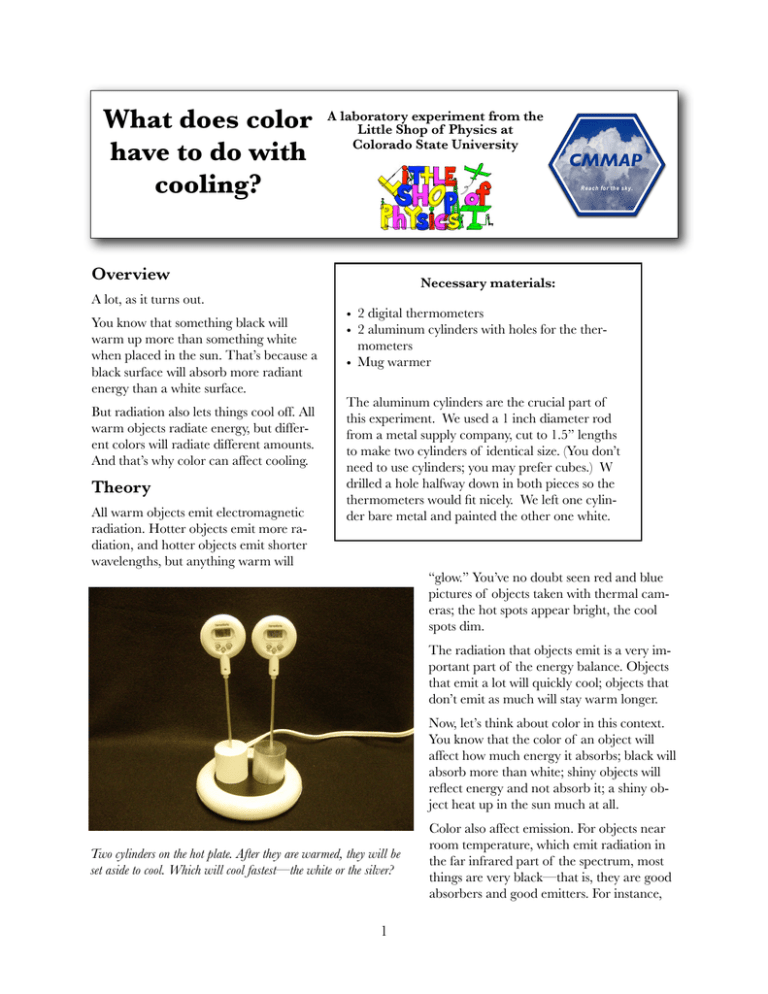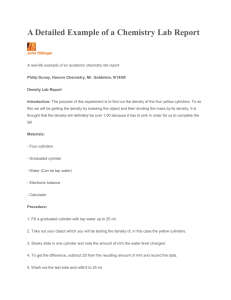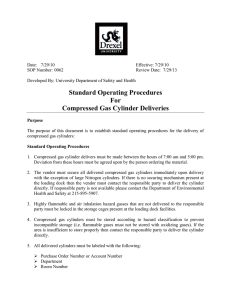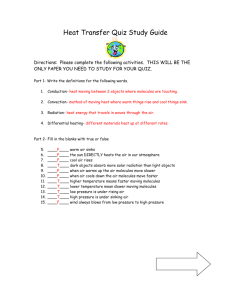What does color have to do with cooling? CMMAP
advertisement

What does color have to do with cooling? A laboratory experiment from the Little Shop of Physics at Colorado State University Reach for the sky. Overview A lot, as it turns out. You know that something black will warm up more than something white when placed in the sun. That’s because a black surface will absorb more radiant energy than a white surface. But radiation also lets things cool off. All warm objects radiate energy, but different colors will radiate different amounts. And that’s why color can affect cooling. Theory All warm objects emit electromagnetic radiation. Hotter objects emit more radiation, and hotter objects emit shorter wavelengths, but anything warm will CMMAP Necessary materials: • 2 digital thermometers • 2 aluminum cylinders with holes for the thermometers • Mug warmer The aluminum cylinders are the crucial part of this experiment. We used a 1 inch diameter rod from a metal supply company, cut to 1.5” lengths to make two cylinders of identical size. (You don’t need to use cylinders; you may prefer cubes.) W drilled a hole halfway down in both pieces so the thermometers would fit nicely. We left one cylinder bare metal and painted the other one white. “glow.” You’ve no doubt seen red and blue pictures of objects taken with thermal cameras; the hot spots appear bright, the cool spots dim. The radiation that objects emit is a very important part of the energy balance. Objects that emit a lot will quickly cool; objects that don’t emit as much will stay warm longer. Now, let’s think about color in this context. You know that the color of an object will affect how much energy it absorbs; black will absorb more than white; shiny objects will reflect energy and not absorb it; a shiny object heat up in the sun much at all. Two cylinders on the hot plate. After they are warmed, they will be set aside to cool. Which will cool fastest—the white or the silver? 1 Color also affect emission. For objects near room temperature, which emit radiation in the far infrared part of the spectrum, most things are very black—that is, they are good absorbers and good emitters. For instance, human skin, regardless of color, is a very good absorber and emitter of far infrared. No matter what color you skin, you are black in the infrared! The same is true of fabrics and of painted surfaces. All colors of clothes and all colors of paint are black in the infrared; they absorb and emit quite nicely. But silvery metals don’t work like this. They reflect visible light and they reflect infrared too. They don’t absorb it—and, more importantly, they don’t emit it! So, in this experiment, the two cylinders will cool at different rates. The bare aluminum cylinder radiates less and cools rapidly; the white cylinder (and the color doesn’t matter—it could be any color at all!) will radiate more and so it will cool off more quickly. This is a very surprising result that drives home the point about the importance of radiation—emission of thermal radiation—in cooling. Doing the Experiment This experiment/demo involves some waiting time. You may want to set up this first part of the demo while your class is engaged in another activity of discussion, and then proceed when ready. This is a great activity for predictions. You should certainly have students vote: Which cylinder do they think will cool off more quickly? Which will cool off less quickly? Most students will guess that the bare cylinder will cool off more quickly. The painted one seems insulated somehow.... In fact, it is! Painting will provide some insulation, limiting conduction. But the increase in radiation far outweighs this effect. Run this as an activity or a demo as follows: • • • • Turn on your mug warmer. Place the white and aluminum finished cylinders on the mug warmer with the holes facing up. Turn on the two digital thermometer and insert one into each cylinder. Wait for about 15 minutes for the cylinders to warm up. They probably won’t warm to the same temperature, your first hint that something is up... When both aluminum cylinders have been warmed, continue the experiment: • Tell your students that you will be removing the cylinders from the heat source. Have them each predict which cylinder will cool the fastest and why. • Record the temperature on the thermometers and then set the cylinders on the table or a hot pad. • Take temperatures at 1 minute intervals and ask: How do the two temperatures vary? • You can stop taking data in a short time, once it becomes clear that the white cylinder is cooling more quickly. Now it’s time to talk about why... Discuss the results. Some questions you could ask: • Why did the white cylinder cool more quickly? • Why are “space blankets” that are used for emergencies made of silvery plastic? • Why is the inside of a thermos silvery as well? Summing Up How does this apply to the earth system? It turns out that there’s an important connection. The earth can’t exchange energy with its surroundings; it can only lose heat by radiation. As we change the composition of the atmosphere, we make this emission less efficient. When the earth cools less efficiently, it stays warmer. And that’s just what we see happening. For More Information CMMAP, the Center for Multi-Scale Modeling of Atmospheric Processes: http://cmmap.colostate.edu Little Shop of Physics: http://littleshop.physics.colostate.edu 2




